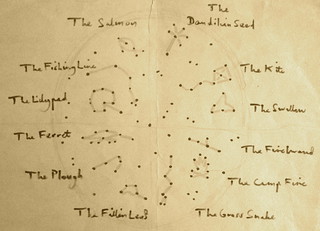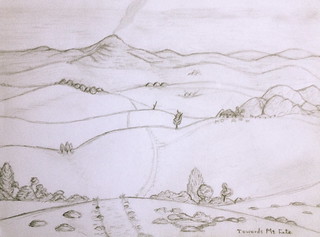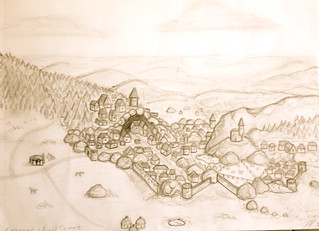For a speculative and religion-derived description of the origin of The Lands as written by one of its own see the excerpt from the Scrolls of Eternity under
Gods & Goddesses. For a more sober history (albeit one still open to dispute or revision) see herein. The history of The Lands is divided into a number of Ages. The significant characteristics and events of these Ages follows...
The Lost Ages
In this time, lasting several thousands of years, hunter-gatherers slowly developed the trappings of civilized life. Elves invented art originally by drawing temporary images in the sands of shore. Dwarves invented the oldest tools by chipping stones. Humans invented the taming of animals and the growing of crops. Such talents developed slowly over generations and were transmitted by trading to all kindred across The Lands.
Most lived a wild and nomadic life but sometimes one of the Dragons - purported agents of the divine - would become impatient with the slow and staggering progress of civilization and would rule over a city-state of its own forging. The Dragon would rule as a sacred monarch but then tire of its work after (say) a century and abandon its charges to rule themselves. Such a state would disintegrate once its Dragon had departed
but the knack of living in larger and more complex groups became more common.
This was a time of mass migrations. Related groups would come together to form a tribal confederacy and each of those developed a national identity. Tribes that specialized in hunting and fighting acted as pathfinding bands for national groups and thus first settled particular areas. These foundational groups tended to become hereditary nobility as generations passed. Once all lands were inhabitated warfare then became a key way in which nations expanded. Historians say that the Lost Ages ended with the written declaration of formation of the Empire of Nerina.
The Age of Glory
This was the age of Empires to South, East, West and North and lasted 1000 years. The Lands looked very different from the way they do now as attested by the oldest maps dating from this era. Consider the following differences from the present Maps (
I and
II):
* Some 200 miles west of (what are now) the Pirate Isles there was an archipelago (covering an area as large as the present-day Salty Sea) known in times since as The Mariner Isles.
* Most forests were larger. Much of the coastal lands between the Hills of Fog and the Many Hills was covered in the ancient Western Forest (now only the Greenwood is left). In contrast the present-day Greatwood Forest was smaller and was confined to the west-bank of the Everflow River.
* Much of the plain along both banks of the Everflow River was a shallow fresh-water inland sea extending from the present-day locations of River Lake to the Shadow Water. The Salty Sea at that time extended all the way to the Lost Hills and Elderwood was semi-salty swampland.
* Mount Fate seems to have only come into existence sometime since the Age of Glory maps were drawn. How a mountain can simply spring from the hills is a matter of debate among scholars.
* The Lands were warmer as well as wetter. The Erimer Sea was cold but its waters never froze over (only the rivers to its north did this). What is now the Southern Desert was grassland much like the Golden Plains are to this day.
Of more interest for historians is the markedly different political landscape of the Age of Glory. As soon as humans in Nerina were ruled by an emperor or empress it was decided by both the Elves and the Dwarves that they too needed such rulers. The Lands now had three empires. Many deeds of harsh glory were done in the shaping of these empires.
The lowlands of Westara were the territory of the Elvish Empire - known also as the Empire of the West. Many Elves still lived a semi-nomadic life by preference and it was usual for an aristocratic family to maintain more than one home (say a coastal villa and an inland encampment). The royal family had both a Summer Palace (still located on present-day Haven Island) and a Winter Garden (which was once located in present-day Grazia). The Elvish Empire was defended by the fact that at any one time several armed retinue effectively patrolled it as they travelled from home to home. However a few towers monitored its inland borders as distinct and longeval monuments to Elvish craft.
That part of the Eastern Expanse between the Sundering Steppes and the Everflow River was the territory of the Dwarvish Empire - known also as the Empire of the East. Its capital was in the Seven Hills and it had mining settlements in the south-east foothills of the Pillar Mountains and the foothills of the Iron Mountains. At this time minerals and metals were plentiful in the rugged hills and it was only much later that miners had to resort to mining in mountains. Mining made the Dwarvish Empire rich. Most of its population were in its hills but it maintained excellent roads in its lowlands.
There was a short but bloody war staged both north and south of the Border Mountains between the Elvish Empire and Dwarvish Empire over salt. The Elves had lots of salt but gave it scant value. In contrast Dwarves love salt but had barely any. The Elves had been selling it to the Dwarves for more and more exorbitant prices. Once the Elvish price hit a pound of gold for a pound of salt the Dwarves took it by force and war began. It is from this time that the expression "rubbing salt in the wound" comes. The Salt War ended once the Empire of the South offered to sell salt at a better price. However it resulted in a long resentment between Elves and Dwarves. Now even a statement like "pass the salt" can cause arguments between members of those two kindred. But back to ancient times.
Nerina was the Empire of the South and extended over much of the Golden Plains from Farport to Mirage. One of its emperors - known to history as Eskandar - decided in 500AG to become both Emperor of the South
and Emperor of Humankind. To make this title a truth Eskandar went on a campaign northward to bring civilization to all humans northward living a life of barbarism. In five years he extended the Empire to include all lands inhabited by the speakers of Lehenic (then as far as present-day Allmeet). In the next five they then marched all the way to the northern limit of the Grey Hills routing and scattering the disparate Brethic and Eriman they met along the way. Eskandar expected to be ruler of all humans between the Erimer Sea and the Gaping Gulf but never expected what arose from the Wandering Lands.
The barbarians of the Wandering Lands had gathered and chosen a ruler from among them - Volund - a warrior of legendary renown who overnight forged an army as powerful and disciplined as that of Eskandar (Volund had in his youth worked as a mercenary in Nerina). With devastating speed his forces turned the tide. Eskandar discovered that his conquests in Westara and the Eastern Expanse were shaky as conquered subjects formed alliances with Volund. The new force pushed Eskandar back to the Golden Plains - only there did his forces have sufficient support and supply from the local population to halt the barbaric advance. All Eriman leaders swore loyalty to Volund (the Brethic chose the alternative path of paying tribute to preserve independence). Now The Lands had
four empires and Volund become Emperor of the North (whose descendants became Emperors or Empresses of Grand Erimania which lasted 500 years).
The Age of Glory ended many generations later with the deaths of the Eriman Emperor Udolfo and his one-time advisor Tara the Usurper.
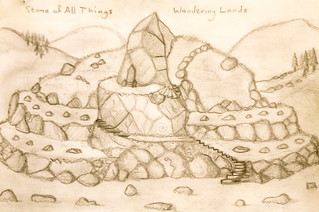 The Age of Tumult
The Age of Tumult
In this time Grand Erimania was rent asunder by a 500 year long civil war which at times also became a war that drew on the other empires and which involved the changing-of-hands of many a province and estate.
Both the Elves to the west and the Dwarves to the east had the practice of exiling violent criminals and these became mercenary troops in the war among Humans. These forces were known as the Drowiri and the Derogar respectively. Legend tells that they were even exiled in spirit and persist as rare demi-human undead.
The Orcs enter history as they came from the Border Mountains to pillage lands wracked by war. Also a new form was bred from captured Orcs and became the Goblins - nocturnal assassins that added an additional level of cruelty to the forces of both sides in the civil war.
The Lands became cooler and drier and many present-day geographic characteristics came to be.
Wild and brutal ways were cultivated in the various civil war factions. This extended even to clothing that made overt use of the body parts of hostile animals - horns and wings adored helms while claws decorated shoulders. Over time all factions in the civil war were drawn into just two - the Blood and the Bile factions. A handful of neutral settlements within Eriman territory persisted and were even valued by the rival factions as sites of both respite and intrigue.
The other empires tended to be isolationist much of this era. The only polity that truly prospered was the island nation that formed from a federation of the five ports of the Mariner Isles. The rulers of the five ports took turns to rule that archipelago by each occupying a decade-long term twice a century and were advised by assorted philosophers and spell-casters. The Mariners of this land profited from trading and were far removed from war. They had a culture known for both its vibrant arts and for young women and men who would perform acrobatics over charging Irates (a long-extinct breed of horned quadruped).
The Age of Tumult ended with the wholesale disappearance of two legions that were all set to do battle in a forgotten Eriman field. For further information on the Age of Tumult see the Legend of the Brethic Royal Dagger under
Sage Scrivenings.
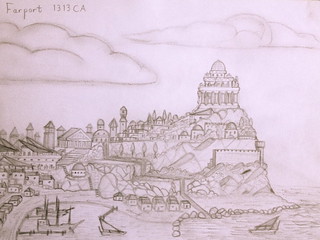 The Common Age
The Common Age
This is the present age which lacks any better name because it is still happening and seems to lack any agreed defining characteristics. Significant dates till close to the present day follow...
1CA - Following the end of the civil war (due to lack of combatants) the mercenary Goblins withdraw to the Border Mountains from which their ancestors had come. However they cannot abide the native Orcs still living there and start a war with them.
50CA – The nations of Rolania and Bordenia are formed. Kinshope asserts its independence from these nations and declares that it will only unite with these under the authority of the original and now lost royal line of Grand Erimania.
109CA - On Farport Peninsula two gigantic corpses wash ashore and cause a sensation among the cosmopolitan crowd there. The squid is as long as a galley. The whale is even larger and as it rots is found to have a small house-boat in its largest buoyancy cavity. Both seem to have perished fighting each other. Only the bones and shells of these monsters - named Kraken and Cetus - survive to be shipped to the Imperial Court of Nerina. They are put on display in the public hall and have been ever since.
110CA - A huge tidal wave hits the shores of Westara. Within days ships of humans wash ashore and the refugees report the total destruction by natural disaster of the Mariner Isles. The Elvish monarch (the title Emperor or Empress now deemed tasteless following the Age of Tumult) must decide how to respond to the hundreds of survivors (as well as those of its own subjects suffering from the tidal wave). Some advise putting all the humans to the sword. Others advise vanquishing them inland to other human nations. Yet others advise offering them a home in Elvish lands. It is the latter course-of-action that is taken. Many humans are taken into Elvish households as servants. Many human orphans are adopted by Elvish parents. The vast difference in life span between the two forms takes its toll on the happiness of such mixed households. Nonetheless the first Half-Elves of any number are born in this time.
111CA - Reports start to circulate in the courts of Bordenia and Rolania that a new mountain has risen from the foothills north-east of the Pillar Mountains. The most common name for this rumour is Mount Fate.
152CA - Nomadic horse-herders start migrating in small but frequent waves from the Sundering Steppes into the Eastern Expanse. They call themselves the Planavic. For now they live in scattered clan settlements. Some clans are hostile to the Dwarves ruling much of this territory but they are quickly defeated by the well-armed and disciplined Dwarves. Other clans however seek peace with the Dwarves and are granted permission to live in the lowlands as vassals to the Dwarvish monarch (the title Emperor or Empress now deemed tasteless following the Age of Tumult) or to live beyond its borders.
230CA - The Dwarf mines of both the Iron Mountains and the south-eastern foothills of the Pillar Mountains have been depleted of all ore that can be got by methods of the time. The working population dwindles.
266CA - A second wave of Planavic nomads invade the Eastern Expanse. They are united under one general - The Katharian (whose name is lent to all his forces) - and wage war on both settled Planavic clans and on the Dwarves. The Dwarves recall all garrisons back to the Seven Hills for defense of the homeland. Among Planavic clans that are conquered by the invaders some warriors become resistance fighters and form the original movement of Rangers.
281CA - Pretenders to the throne of Grand Erimania become something of a fad in Bordenia and Rolania. Most such pretenders are obscure. However one commoner in Rolania claiming royal blood sparks a bloody revolt across several estates. A few months later in Bordenia one baroness presents documents showing her royal ancestry and once they are declared fake she wages war on her peers. Both military adventures end with the deaths of the instigators (as well as of many innocents). In both nations a new knightly order - the Palsgrave or Paladins - is formed with the function of both assessing the veracity of royal claims and of providing military response to any resulting belligerence.
306CA - Humans living as subjects of the Elves have grown in population to rival that of the Elves. Those humans who lack the sponsorship of an Elvish household (of which there are a growing number) must live by decree in a number of gated human settlements. The largest is Nartellfar in the Bay of Nar from which these human guests draw the kinship name of Narman. Tensions grow between the host and guest kindreds.
325CA - Twelve still free Planavic clans unite under the leadership of the Dunothev Clan to repel invading Katharians back to the Sundering Steppes. The current Katharian (granddaughter of the original) is killed by the Patron & Matron of the Dunothev. These two are a warior and mage respectively and become role-models in Rovnaran tradition. Once the invaders are repelled the nation of Rovnara is formed with the Dunothev Clan as the royal family. Most Katharians return to the Sundering Steppes but some stay in the Eastern Expanse as bandits.
390CA - The wandering Zinda travel across the Southern Desert to seek work and make homes in the Empire of Nerina. They are accepted by the government but suffer prejudice at the hands of the locals. Some try to settle but many others continue wandering from village to village as tinkers and fortune-tellers and household servants for hire.
421CA - An ascetic hermitage of Lehenic sages and scribes that has existed since the Age of Tumult on the Ragged Isles suffers an unusually swift plague that kills all its members. The records they have been keeping are left to the ravages of time.
464CA - The War of the Orcs & Goblins is lost by the Orcs whose population has been reduced to a fraction of its original size. Still intact bands flee south of the Border Mountains. Some scatter and become mingled with gangs of human bandits and thus the first Half-Orcs in numbers are born. Most however travel further and storm the Iron Mountains. They succeed in routing the Dwarves there whose population and forces have dwindled over time.
490CA - The capital of Nerina is temporarily transferred to the city of Mirage for a period of 30 years till a new Empress returns it to Nerina City.
501CA - Notices magically appear in town squares all over The Lands challenging adventurers to take the Test of Mount Fate. It seems that someone calling themselves The Castellan has constructed a maze under the mountain and wants to see if anyone can survive it. A surprising number of adventurers make way to the mountain to never return.
566CA – The Elvish Monarch falls into a ten day trance and, on recovering, withdraws the authority of his nation over most of its territory to the northern side of the Rushing River. The Summer Palace on Haven Island becomes permanent capital of the Elves. The faraway Winter Garden is ransacked by a human mob. Ownership of the Tower of Lore is granted to a body of human scholars. Nartellfar becomes capital of the new maritime Monarchy of the Narmans which is recognized by the Elvish Monarch. In return for such recognition the Narman monarch agrees that all Elves still residing in former Elvish territory are given the same rights as Narman subjects. Most Elves withdraw to the reduced territory of Haven but most Half-Elves stay.
567CA - An expedition of Elvish migrants form a new isolationist homeland in the eastern arm of the Greatwood Forest - The Woodland Realm. From this time onward the distinction between Meadow Elves (Eldenari) and Wood Elves (Evenari) is drawn.
606CA – Ivana is founded by 'fifteen founding families' (themselves drawn from three Plana clans) on the shores of the Shadow Water. The distant monarch of Rovnara grants the ruler of the city the title of Duke or Duchess.
646CA - The Narman monarch grants city charters to the human settlements of Port Grazia, Delmisar, Orvilia, Traviata and Urbana. Some of these are brand-new townships while others are on the sites of former Elvish settlements.
667CA - In the Sea Cities new kinds of mage arise with the development of specialist schools of magic. The first of these is the School of Illusion in Nartellfar.
703CA – An army of Dwarves re-takes the Iron Mountains from the Orcs with help from Ivana (known as the Battle of the Orcs & Dwarves). They convert the old iron mines of Mount Hammer into a new citadel for this revived colony. New deeper mines are dug. The Dwarves start trading with and even investing in the enterprises of the humans of Ivana.
704CA - Orcs who survived the Battle of the Dwarves & Orcs flee towards the original homeland of the Border Mountains. Some bands get lost in the Greatwood Forest and are exterminated in the Battle of the Orcs & Elves. Most however return to the Border Mountains and start the second War of the Orcs & Goblins. These battle-hardened bands quickly take much territory. However at this time Hobgoblins are suddenly born among the Goblins and become powerful new warriors in this bloodthirsty war.
712CA - In response to both growing travel between Rolania and Bordenia, and continuing bandit and Orcish activity between those nations, both nations station a combined garrison in the valley of Allmeet to defend the overland route between Westara and the Eastern Expanse.
793CA - Trading along the coast from Nartellfar to Nerina City has grown markedly and with it has come piracy. Narman pirates are particularly concentrated in what are now named the Pirate Isles.
824CA - Another wave of Katharians invade the Eastern Expanse. It is much weaker however that that of five centuries before, and the Dwarves easily defend the Seven Hills. Nonetheless they cause much havoc. Rovnara is assisted in its battles by Bordenia and the Compact of Defense arises from this alliance. Ivana boosts its forces by hiring mercenary troops. Scattered settlements across the Eastern Expanse are well-served by the clandestine force of the Rangers. Once more the Katharians are vanquished once their leader is killed.
858CA - A meteor strikes a hill in the vacinity of Allmeet. The hill is excavated for meteoric iron and a number of peculiar corpses are discovered there. Those corpses of alien origin are named the Occu and the Ilkithiri (for there seem to be two kinds) and are studied in the vaults of Allmeet.
942CA - In Rolania a province is set aside in which the Halflings of the nation can gather and live together. This is done in part because of Halfling wishes and partly because many humans consider the Halfings to be nothing but beggars and better living far away.
999CA – Farport declares independence from the Empire of Nerina.
1000CA - The Governor of the Tower of Lore sends an expedition to the Ragged Isles to revive the hermitage there and rescue its store of books and scrolls from turning to dust.
1013CA - The bandit Gwilherm the Grim declares himself Baron Of The Marches in parts of the Grey Hills deemed Bordenian territory. His short but bloody misrule is ended by a combined force of neighbouring Bordenian estates.
1036CA - The guilds of Nartellfar foment revolt and expel the Narman monarchy which withdraws to Delmisar. The republic of Nartellfar is declared.
1049CA – Following a popular revolt the republic of Delmisar is declared. What is left of the royal family withdraw to Orvilia.
1050CA - The subjects of Orvilia ratify the Narman Monarchy in a new constitutional form. From this time on every barony from Port Grazia to Urbana continues to owe its loyalty to the Narman Monarch but acts with ever-bolder autonomy. Some promote themselves to status of duchy from time-to-time (depending on the tastes of the current title-holder).
1057CA - The newly formed Aristocratic Alliance of angry gentry seek to overthrow and replace the Monarch in Orvilia but are thwarted by a combined force of all three Sea Cities. The League of Lasting Peace & Prosperity is formed between Nartellfar, Delmisar and Orvilia. Aristocratic Alliance members are granted safety by the Viceroy of Traviata far inland on the Rushing River, while others flee along the coast to Port Grazia.
1086CA – Kelda is founded by Planavic farmers and pastoralists. The first game of Gruntball is played on its common.
1111CA – The Seven Hills fall to invasion by Hill Giants. The Monarchy-in-Exile removes to Fugitives Forge (a fortress that defended old copper mines in the south-eastern hills of the Pillar Mountains) while the majority of civilian survivors move to the Iron Mountains. From this time onwards a distinction is drawn between Hill Dwarves (Holemgar) and Mountain Dwarves (Karumgar).
1191CA - The Aristocratic Alliance have been secretly fomenting outrage among the nobility of Rolania over the growth of republican government in the Sea Cities. A small but decisive majority of Rolanian barons and baronesses push for war. The only firm opposition comes from the Paladins (who can only advise) so the Protector declares war on the Sea Cities which are taken by surprise and each city has to survive its own siege.
1202CA - Kinshope suffers an unusually long bout of Sleeping Sickness. Celebrants gather from across the Wandering Lands to help stave off thirst and hunger while the afflication takes its course in the suddenly still township.
1215CA - The intermittent Narman-Eriman War comes to an end. The more diverse and inventive forces of the Sea Cities have pushed far inland and captured the province of Hinhome. Rolania is now suffering due to a shortage of both labour and food resulting from the long war (and Bordenia can only offer so much help). The Sea Cities offer incentives to Rolanian deserters with some effect. Rolania agrees to end its aggression and the Sea Cities withdraw.
1216CA - The Sea Cities form the secret service known as the Tapestry to ensure that they will be aware in advance of any developments in The Lands that may threaten the peace or prosperity of the Sea Cities.
1217CA – Hinhome is granted its independence by Rolania on condition of the Halfling homeland continuing in the capacity of a military vassal state. The Sea Cities however change the terms to insist that it only come to the aid of Rolania in the case of a war of defense rather than aggression.
1236CA - Seeing that the Seven Hills are still lost after more than a century, the current ruler of Mount Hammer declares himself the new Monarch of Mount Hammer (while still recognizing the Monarch-In-Exile as the rightful ruler of the Seven Hills rather than of all Dwarves). Hill Dwarves riot in all the places they live in numbers (including human cities).
1260CA - The Duke of Ivana calls on the services of the Battering Ram mercenary company to quell conflict in the streets between young hotbloods of its Fifteen Founding Families. Once the job is done the mostly Lehenic mercenary force stays despite the resentment of the nobility and becomes an autonomous city guard.
1276CA - Keldan merchants have formed two separate guilds - one for native Planavic members and another for Eriman members. The latter attempts to take control of the ruling council from the former. Blows are struck inside the town hall and soon a brawl spills into the streets and the city is reduced to a civil war with fighting extending into the surrounding farmland over many months. Tensions arise across the Eastern Expanse till the Rangers intervene and end the conflict in Kelda by expelling instigators on both sides.
1287CA - The Southern Desert is growing. The Empire Of Nerina imposes export duties on luxury items such as colourful dyes so as to preserve its own domestic supply. This starts a trend to the north for duller clothes which are then rationalized as more honest and hardy. However there are always those prepared to buck a trend.
1290CA - Port Grazia becomes capital of the military regime of the Grazia Confederacy. Its secret service The Adamantine Network is formed. Port Grazia provides military support to settling farmers in the Many Hills who have come into conflict with the Centaurs in that area. By association it is deemed that hostility is now brewing between the Grazia Confederacy and the Woodland Realm.
1296CA – The recently formed Arcane Coterie occupy the abandoned and supposedly haunted Tower of Mist.
1300CA - The nobility and even merchant councillors of the city of Traviata are overthrown by a popular revolt. The Viceroy takes refuge in Urbana further inland. The citizenry of Traviata are yet to finalize a new form of government. Many suspect war will happen between the citizenry of Traviata and the Barony of Urbana.
1303CA - The once independently-minded pirates of the Pirate Isles unite under the banner of the Crossed Blades.
1305CA - The Inaugural Census of Nartellfar is conducted. Many remark on just how many citizens have Elvish blood (one-in-ten).
1308CA - Farport is afflicted with the largest recorded case of Dancing Fever in history. This is somewhat tempered by the fact it happens during the Festival of Sails and so seems fitting.
1311CA - Following a shooting star and an unusually misty morning the city of Mirage becomes the home of a new and suddenly popular cult -
The Ilk - who promise renewed life and power and whose emblem is a distinctive looped cross. Within months the Ilk have cells across the Empire of Nerina.
1312CA - All contact is lost with the hermitage on the Ragged Isles. A survey ship sent by the Tower of Lore to investigate never returns. Also a new cult offering salvation from some coming doom emerges in Nerina City and beyond -
The Occult - whose emblem is a dot in a circle in a five-pointed star - known as the Seeing Star.




